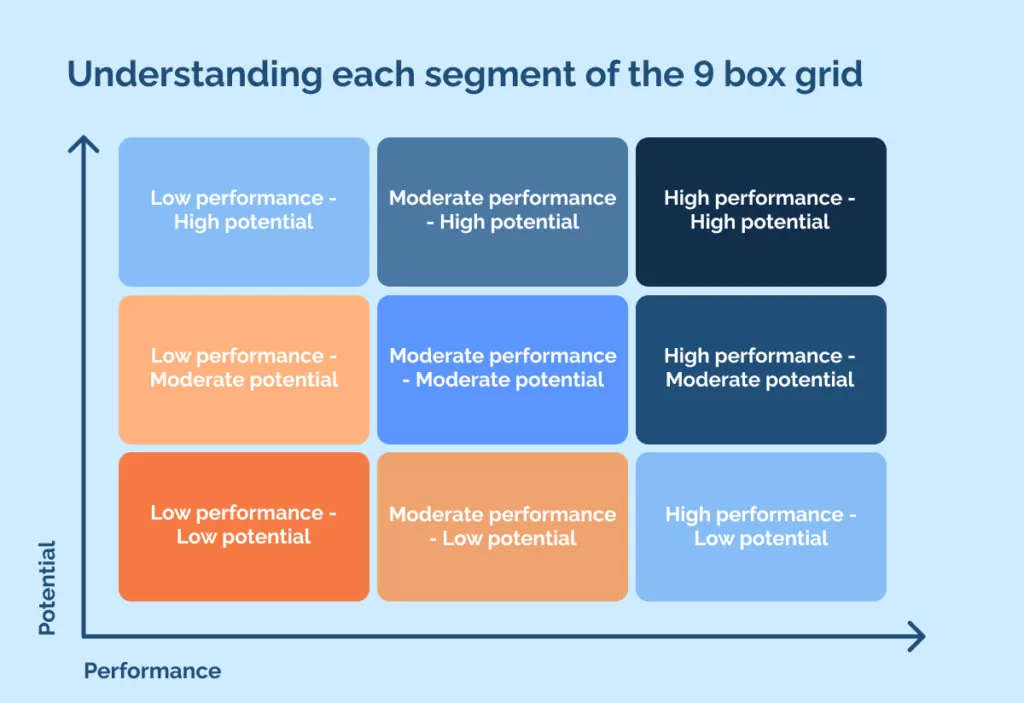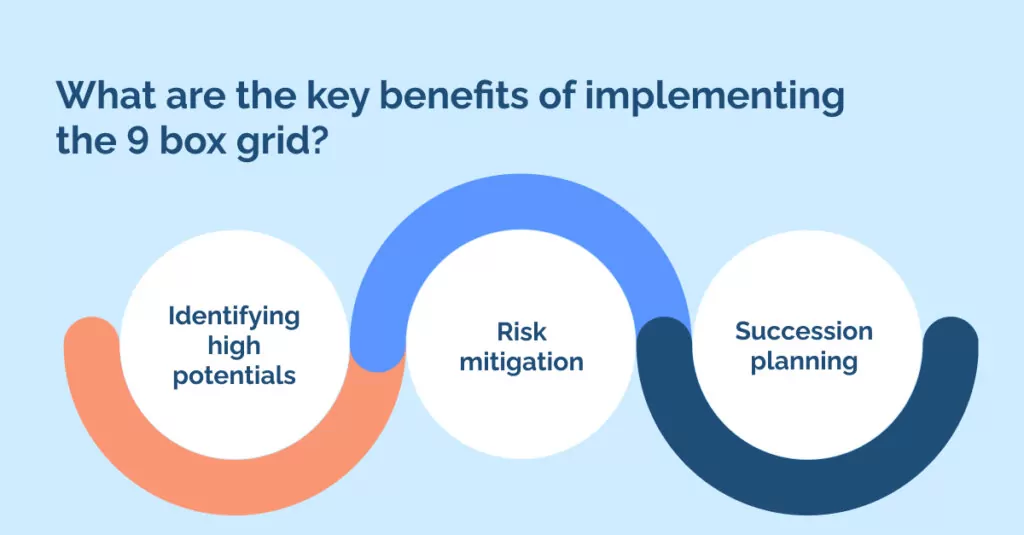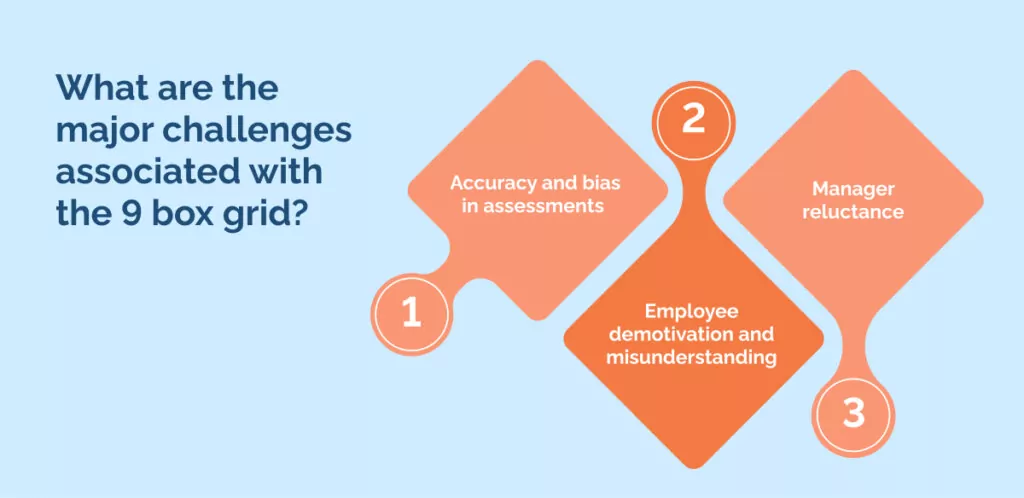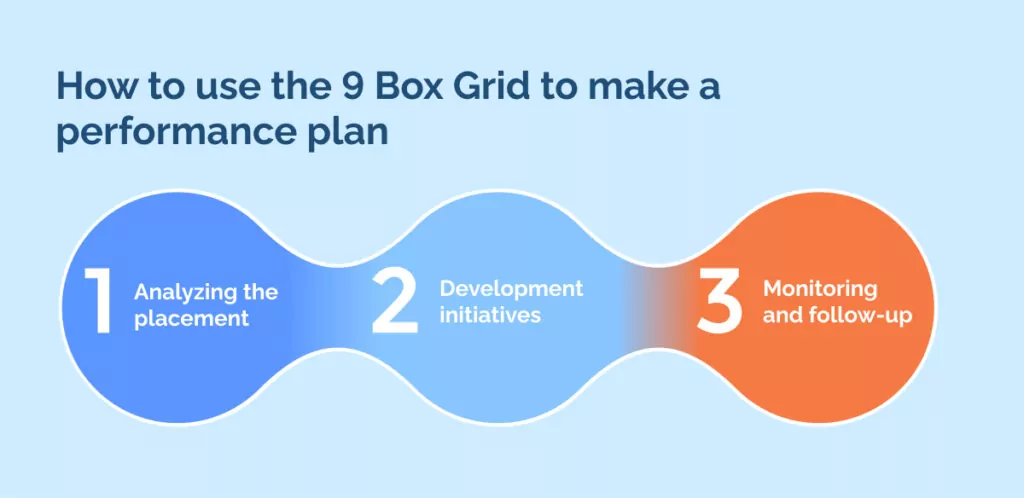
The 9 Box grid is a straightforward yet powerful method for assessing and developing employee potential. Understanding and effectively using this tool can help you unlock the full potential of your workforce.
In this article, we’ll delve into what the 9 Box grid is, its critical role in talent management, and how it can revolutionize the way you perceive and nurture talent within your organization.
By the end of this guide, you’ll be equipped with the knowledge to effectively implement this strategy, ensuring that your organization stays ahead in the competitive world of business through optimal talent management.
What is the 9 box grid?
The 9 box grid is a matrix that helps you map out employees based on two key factors: their performance and their potential.
The grid is divided into nine boxes, each representing a different combination of performance and potential.
Typically, the vertical axis indicates potential, ranging from low to high, while the horizontal axis represents current performance, also from low to high.
What do the horizontal and vertical axes represent?
Here’s a brief overview of what each axis represents:
Performance (Horizontal Axis)
This measures how well an employee is meeting or exceeding their current job responsibilities.
It’s often based on the most recent performance evaluations.
Potential (Vertical Axis)
This is a bit more nuanced and subjective. It assesses the employee’s ability to grow and take on more significant or complex roles in the future.
Factors like adaptability, learning ability, and leadership qualities are considered here.
When you place your employees within this grid, you’re able to see a clearer picture of your workforce. You’ll identify high performers with high potential, solid performers with good potential, and underperformers who may need development or a different role.
Understanding each segment of the 9 box grid

Each of the nine segments in the grid represents a unique combination of performance and potential, which we’ll explain below:
Low performance – Low potential
Employees here may be struggling or may not be a good fit for their current roles. They might require additional employee training, a role change, or, in some cases, an exit strategy.
Low performance – Moderate potential
These employees have the potential to grow but are currently underperforming. They might benefit from coaching, mentoring, or a revised development plan.
Low performance – High potential
These individuals have high potential but are not meeting current performance standards. This could be due to a mismatch in roles or the need for targeted skill development.
Moderate performance – Low potential
Employees in this category are solid performers but have limited potential for growth. They can be valuable in their current roles and might require role-specific training to enhance their skills.
Moderate performance – Moderate potential
This group does well in their current roles and has the potential to grow further. Targeted development plans and career pathing can help in harnessing their full potential.
Moderate performance – High potential
These employees are doing well and have a high potential for future roles. Investing in their development through leadership training or challenging projects can prepare them for advanced responsibilities.
High performance – Low potential
These are your star performers in their current roles but may not have the potential or desire for higher roles. Recognizing their contributions and ensuring job satisfaction is crucial here.
High performance – Moderate potential
High performers with good potential for advancement. They are prime candidates for succession planning and more significant responsibilities.
High performance – High potential
These are your top talents, excelling in their roles and demonstrating high potential for leadership. They are ideal for fast-track development programs and leadership roles.
What are the key benefits of implementing the 9 box grid?

The 9 Box grid is more than just a talent management tool; it’s a strategic asset for your organization.
By implementing this grid, you gain valuable insights into your workforce, which can drive crucial business decisions.
Here are three ways the 9 box model delivers tangible benefits:
1. Identifying high potentials
The 9 Box grid is exceptionally effective in highlighting employees with significant growth potential.
By assessing both their current performance and their future potential, you can spot those who are not just excelling in their current roles but also have the capacity to take on more complex, higher-level tasks.
This recognition is crucial for nurturing talent within your organization. It allows you to focus your development efforts on individuals who are most likely to drive your business forward in the future.
By investing in these high-potential individuals, you’re building a robust pipeline of skilled leaders and innovators.
2. Risk mitigation
One of the core strengths of the 9 Box grid is its ability to reveal gaps in employee performance and potential.
This insight is vital for risk management in your talent strategy. Employees who show low performance and potential might indicate a need for role realignment, additional training, or even a reassessment of their fit in the organization.
Similarly, high-performing employees with low potential for growth may require initiatives to enhance job satisfaction and retention.
By proactively managing these different segments, you can address potential risks before they escalate, ensuring a more stable and efficient workforce.
3. Succession planning
Succession planning is critical for the sustainability and long-term success of any business. The 9 Box grid plays a pivotal role in this process.
It helps you identify not just your current star performers, but also those with the ability to grow into future leaders. This foresight enables you to prepare for inevitable changes, such as retirements, resignations, or expansion.
By using the grid to map out where your potential future leaders are and what development they need, you ensure a continuous flow of leadership and minimal disruption to your business operations.
In essence, it’s about preparing today for the leadership your company will need tomorrow.
What are the major challenges associated with the 9 box grid?

Implementing the 9 Box grid can significantly enhance your talent management approach, but it’s not without its challenges.
Understanding these hurdles and having strategies in place to overcome them is crucial for successful implementation.
The three obstacles we think you definitely need to be ready to take on are:
1. Accuracy and bias in assessments
Ensuring accurate, unbiased assessments of performance and potential is challenging. Inconsistencies and subjectivity in evaluations can undermine the effectiveness of the grid.
2. Employee demotivation and misunderstanding
The categorization within the grid might lead to demotivation or misunderstandings among employees, particularly those placed in lower potential or performance quadrants.
3. Manager reluctance
Some managers may be hesitant to categorize their team members, either due to a reluctance to engage in difficult conversations or a lack of confidence in their assessment skills.
How to use the 9 Box Grid to make a performance plan

Once you have placed your employees on the 9 Box grid, you can use this strategic tool to develop individualized performance plans.
These plans are crucial in managing talent effectively and ensuring that each employee has the opportunity to grow and contribute to the organization’s success.
Here are the 3 core steps to using the 9 box grid to make a performance plan:
Step 1: Analyzing the placement
Begin by analyzing where each employee falls on the grid. This placement gives you insight into their current performance level and potential for future growth.
For instance, someone in the ‘High Performance – High Potential’ quadrant is a strong candidate for leadership development, while someone in the ‘Low Performance – Low Potential’ quadrant might need a performance improvement plan or a role change.
Understanding each employee’s position on the grid allows you to tailor your approach to their specific needs and career trajectory.
Step 2: Development initiatives
Based on the analysis, design development initiatives tailored to each quadrant:
High Potential Employees: Consider leadership training, mentoring, and stretch assignments to prepare them for future roles.
Solid Performers: Focus on role-specific training and continuous skill development to enhance their current performance.
Underperformers with Potential: Implement coaching and personal development plans to address performance gaps and harness their potential.
Low Performers with Low Potential: Explore role realignment or, as a last resort, exit strategies if there’s no improvement.
It’s important to communicate clearly with each employee about their development path and the rationale behind it. This clarity helps in maintaining transparency and motivation.
Step 3: Monitoring and follow-up
Finally, establish a process to monitor progress and adjust the plans as needed.
Regular check-ins with employees are essential for discussing their progress, addressing any challenges, and providing ongoing support and feedback.
Revisit the 9 Box grid periodically to re-assess employee placement and update development plans accordingly. This step is crucial as employees’ performance levels and potential can change over time.
The 9 box grid: A simple, minimal talent management solution
The 9 box grid helps you make informed decisions about employee development, succession planning, and overall organizational growth.
By implementing this tool, you can ensure a more focused, fair, and forward-looking approach to managing your most valuable asset— your people.
But it’s only a small part of the puzzle. Effective talent management requires vision, a robust strategy, and sophisticated talent analytics.
The 9 box grid can provide clarity and direction in managing a diverse workforce, making it invaluable in today’s dynamic business environment.
Whether you’re looking to identify future leaders, enhance team performance, or align employee growth with your organizational goals, the 9 Box grid can be a pivotal tool in helping you achieve your objectives.
FAQs
What is talent management?
9 box is a tool that sits under the practice of “talent management”, which is a critical element in modern business. While antiquated views see the employee-employer relationship as purely transactional, the more modern (and better) theories on talent management paint a different picture.
It’s a strategic process that focuses on ensuring the right people are in the right roles, with the right skills, at the right time. The goal of talent management is to create a high-performance, sustainable organization that meets its strategic and operational goals
In a McKinsey survey it was revealed that 99% of respondents with effective talent management outperform their competitors, and the 9 box grid is a great way to initiate your talent management strategy.
WalkMe Team
WalkMe spearheaded the Digital Adoption Platform (DAP) for associations to use the maximum capacity of their advanced resources. Utilizing man-made consciousness, AI, and context-oriented direction, WalkMe adds a powerful UI layer to raise the computerized proficiency, everything being equal.



